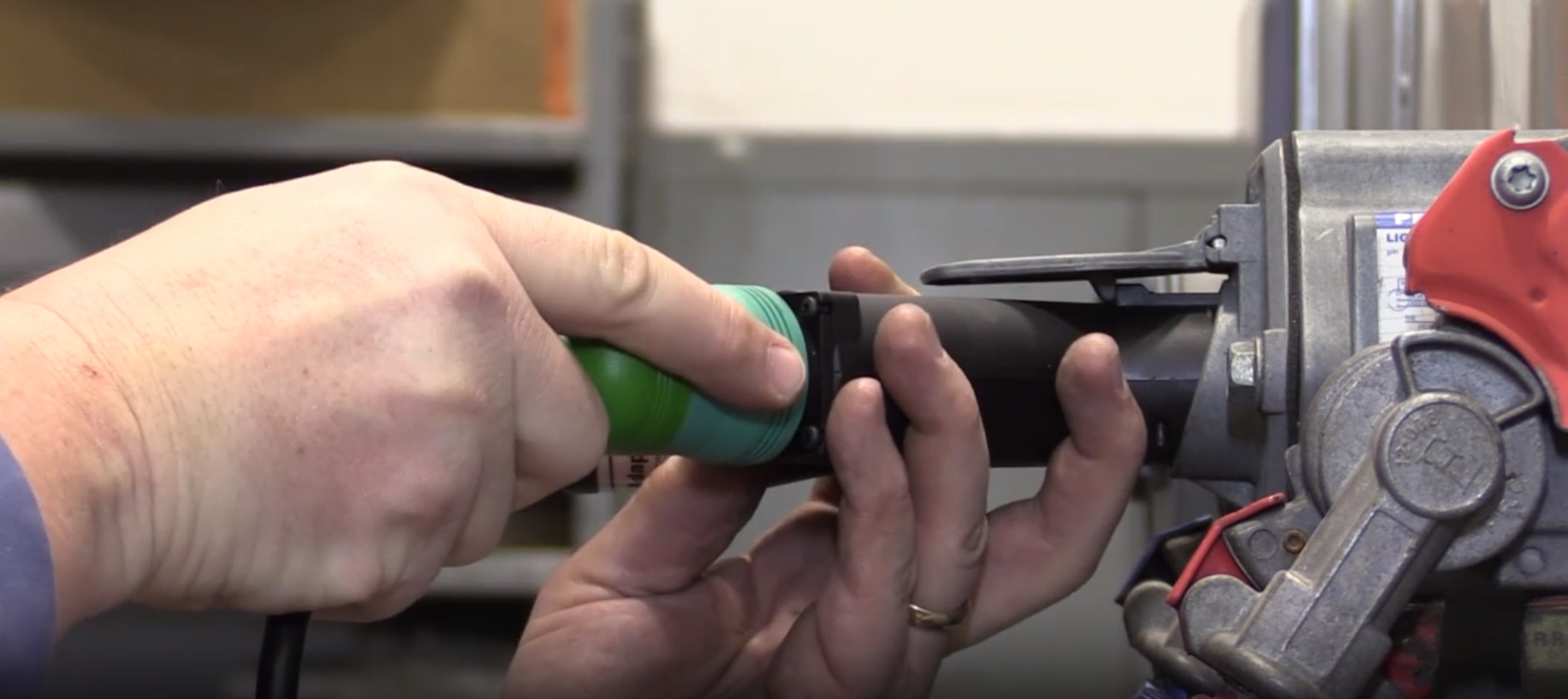The latest chapter in the evolving story of electric vehicles (EV) begins with a tale of two very different models.
One is downright sexy, with alluring aerodynamic lines and head-turning, sporty styling. The other is, well, downright cute — a spunky little thing that looks a bit like a colorful helmet on wheels.
At first glance, the Tesla Roadster (LEFT) and the Myers Motors No More Gas (MM NmG) (RIGHT) — an evolution of the former Corbin Sparrow — appear to be at such opposite ends of the EV spectrum that it seems almost pointless to compare them.
 The Roadster, for example, rockets from 0 to 60 mph in four seconds with a top speed of 130 mph and travels 250 miles on a single battery charge. The NmG accelerates 0 to 60 mph in 12.5 seconds with a top speed of 70 mph and travels 25 to 30 miles on one charge. While the differences in the two vehicles are striking, they do have one common factor: they’re both playing important roles in the continuing attempts to put more drivers behind the wheels of mass-produced, pure electric cars.
The Roadster, for example, rockets from 0 to 60 mph in four seconds with a top speed of 130 mph and travels 250 miles on a single battery charge. The NmG accelerates 0 to 60 mph in 12.5 seconds with a top speed of 70 mph and travels 25 to 30 miles on one charge. While the differences in the two vehicles are striking, they do have one common factor: they’re both playing important roles in the continuing attempts to put more drivers behind the wheels of mass-produced, pure electric cars.
The Electric Vehicle: A Little EV Background
Electric vehicles first made their appearance in the United States in 1835, when Thomas Davenport built the first practical one, a small locomotive. In 1859, French physicist Gaston Planté invented the rechargeable lead-acid storage battery, later improved in 1881 by fellow Frenchman Camille Faure, who then advanced the concept to become the basic lead-acid battery used in automobiles.
The NmG: Bringing EVs Back
In 2005, Tallmadge, OH-based Myers Motors stepped up with the next attempts to make EVs a more tangible reality for the American car consumer.
“There is a growing demand for electric vehicles because they are the most effective ways to solve the problems of energy security and human contribution to global warning,” said Dana Myers, CEO of Myers Motors. “Electricity already has a national infrastructure of generation, transmission and distribution. It costs less per mile, in fuel, of any other alternative — about one-fifth less than $2 per gallon of gasoline in the average car.”
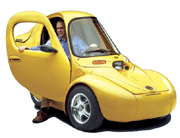 The company’s NmG (No More Gas) is an all-electric, single-passenger, three-wheeled vehicle that registers, insures and parks as a motorcycle and looks a little bit like it drove straight out of a “Jetsons” cartoon. And in fact, the car did make a cameo appearance in the movie Austin Powers in Goldmember.
The company’s NmG (No More Gas) is an all-electric, single-passenger, three-wheeled vehicle that registers, insures and parks as a motorcycle and looks a little bit like it drove straight out of a “Jetsons” cartoon. And in fact, the car did make a cameo appearance in the movie Austin Powers in Goldmember.
“I like our vehicle because it doesn’t look like your average car on the road,” Myers said. “That makes it an attention magnet! The more people see NmGs being driven, the more people will want to drive electric vehicles because they will see how fun and cool they are, as well as realize the benefits they gain when they stop using gas.”
The NmG should look familiar to people who are keeping an eye on the EV scene: The whimsical vehicle is a descendant of the original Corbin Motors Sparrow. In 2004, Myers Motors purchased assets of the then-bankrupt Corbin Motors, at which point engineers spent 18 months redeveloping and upgrading the entire transport system, electronics and charging systems.
Now, the NmG has an intelligent, programmable, water-cooled controller; 13 deep cycle Optima AGM batteries operating at 156 nominal pack voltage; and an 8” DC brushed electrical motor. The belt-driven vehicle has forward and reverse gears and no transmission. With standard control settings, the horsepower usually spikes to 36, then levels and maintains 31 to 33 hp.
“The NmG will out-accelerate most vehicles up to about 25 mph because it has instant torque,” Myers said. “We are actually running the vehicle on less than half the power available, because otherwise it would turn into a race car on the city streets.”
The NmG’s standard lead-acid battery pack gives it a 30-mile range per charge, “though it’s more like 20 miles if you want the batteries to last the optimum amount of time,” Myers said. The pack charges from empty to 95% full in about 45 minutes with a 220-volt charger. A 110-volt charger will charge the vehicle in about six to eight hours. Electricity costs about 2 cents per mile.
Myers Motors also offers a vehicle with a 100-mile-range battery pack; however, “since 80% of all travel is less than 60 miles per day, 100 miles is probably a bit of overkill,” Myers said.
Consumers who buy the NmG might also find relief in the fact that it might not be in the shop as often as their other cars. “On the whole, electric vehicles have fewer parts that can go bad than a comparable gasoline-powered vehicle,” Myers said, adding that her company works closely with repair shops that service the NmG. “We send them documents and talk them through any problems they encounter.”
Brakes, wipers, headlights, suspension and steering systems on the vehicle all need regular maintenance, and the lead-acid battery needs to be changed out at the end of its life. The NmG has a warranty for 12 months or 12,000 miles.
While Myers said that, in terms of inspirational spark, a comparison could be made between her company and automotive dreamers such as Preston Tucker and John DeLorean, the EV concept as a whole is much more solid.
“Like Tucker and DeLorean, we are definitely trying to do something that the major car companies are not yet doing. However, at some point in time I think it is inevitable that virtually all transportation will be electric-powered. Our vehicle, formerly the Sparrow and now the NmG, has already sold 300 vehicles, which is six times more than what Tucker sold.”
The NmG retails for about $24,000.
The Tesla Roadster Roars on to the Scene
On July 19, 2006, a crowd of car buffs witnessed the world debut of the Tesla Roadster, (http://www.teslamotors.com) described by the San Carlos-based company as “performance, style and efficiency with a conscience.”
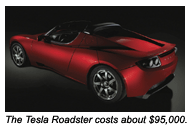 “Our goal is to give customers a great car that they enjoy driving,” said Darryl Siry, vice president of marketing for Tesla Motors. “We want to change the previous paradigm that EVs are necessarily slow, ugly and full of compromises.”
“Our goal is to give customers a great car that they enjoy driving,” said Darryl Siry, vice president of marketing for Tesla Motors. “We want to change the previous paradigm that EVs are necessarily slow, ugly and full of compromises.”
With a two-person capacity and aerodynamic contours, the lightweight convertible sports car can travel the equivalent of 135 mpg (costing about 1 cent per mile) and up to 250 miles (EPA highway) on a single charge, which takes about three-and-a-half hours. Its extended range is due to its state-of-the-art lithium-ion Energy Storage System (ESS), which provides power to the entire vehicle, including the motor.
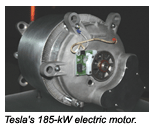
Its battery pack has been under development for more than three years and, utilizing 6,831 lithium-ion cells, is one of the largest and most technically advanced lithium-ion battery packs in the world, according to the company’s white papers.
“Battery technology has greatly improved, both on the chemistry side and on the manufacturing side,” Siry said. “There have been many more improvements in electronics and car design and manufacturing, but improvements in batteries are most important.”
In addition to the lithium-ion cells, the Roadster’s ESS durable, tamper-resistant enclosure includes a network of microprocessors for maintaining charge balance and battery temperature, a cooling system, and an independent safety system designed to disconnect power outside the enclosure under a variety of detectable safety situations.
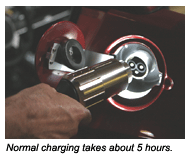
The Tesla Roadster also utilizes a three-phase, four-pole AC induction motor and a distinctive two-speed electrically actuated manual transmission. The motor is controlled by the Power Electronics Module (PEM), which also controls the inverting direct current to three-phase alternating current, charging and braking systems.
All components work together to provide 250 hp.
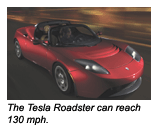
“The electric motor, transmission, power electronics and battery pack should not require any routine maintenance,” Siry said, adding that because of the regenerative braking, the brakes also should not require as much routine maintenance. Wipers and tires, he said, will need regular checks and replacements.
The warranty for the Roadster is still in development, Siry said, and Tesla Motors will handle all repairs.
“Tesla Motors will offer a premium ownership experience,” he said. “Consistent with this philosophy, Tesla Motors will handle all maintenance and repairs directly. We have the unique expertise to service both our electric drivetrain and the other ‘normal’ parts that exist on internal combustion engine cars, such as brakes, tires and washer fluid.” Like Myers, Siry also doesn’t think his company falls under the same big dreams/little results category as the Tucker and DeLorean ventures.
“Tucker and DeLorean had to try to build cars in an era where the major car manufacturers were vertically integrated. They had to build everything themselves,” he said. “Since then, the supply chain has de-integrated in Detroit. We have access to many of the same suppliers as the Big Three.
“Secondly, Tucker and DeLorean were building essentially the same thing that the competition had to offer. Tesla is establishing an entirely new category. We are charting out what is mostly uninhabited territory right now.”
During the four months following the unveiling of the Roadster in late-July, 2007, Tesla Motors filled all reservations — more than 220 — for the 2007 model. The company is now accepting reservations for the 2008 model. The Tesla Roadster retails at a base price of $92,000.
Hope for the Future
Both executives have clear reasons why they want to be at the forefront of this evolving automotive revolution.
“I hope that my infant daughter grows up in a world where we have significantly less terror inspired by Western dependence on Middle Eastern oil,” Siry said. “What I find, though, is that everyone at Tesla has his or her own personal inspiration or passion.
For some, it is developing breakthrough technology. For others, it’s to help the environment. Some are just gearheads who love fast and unique cars. Everyone shares the desire to build a great and historic company.”
Myers source of motivation also comes from an altruistic and hopeful place.
“I’m in this business because I saw it as a way to make a positive contribution and do something that seemed really significant to me.”
Source: Underhood Service, April 2007


